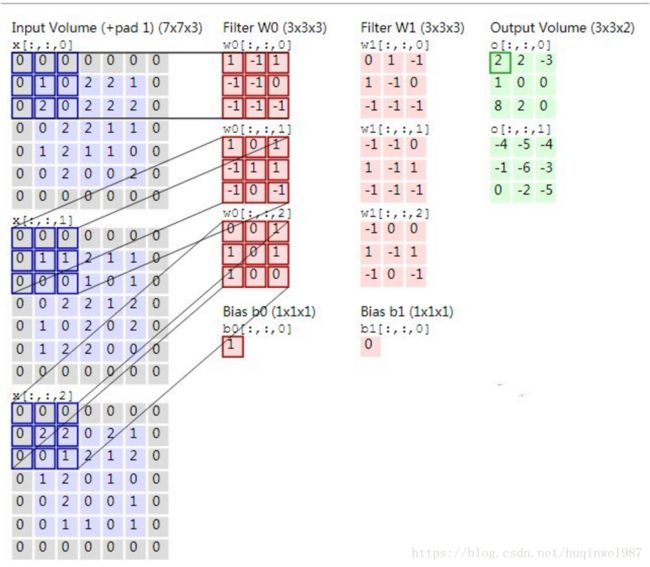手动实现卷积神经网络中的卷积操作(conv2d)
写这个的原因:一来好像没怎么搜到别人手动实现,作为补充;二来巩固一下基础。
卷积操作示意
先从一张示意图说起,卷积基础概念和操作步骤就不啰嗦了,只讲这张图,大意就是,有in-channel,有out-channel,你需要把in-channel都做卷积操作,然后产出out-channel,所以这个w是要层层拆解,w分拆成w0和w1,以对应2个out-channel。w0分拆成3个矩阵w0[:,:,0]、w0[:,:,1]、w0[:,:,2],以对应3个in-channel,因为输入的3通道终究要合而为一的(进入一个核):y0=w0*x+b0、y1=w1*x+b1,所以w0只有一个b0对应,而不是三个。又因为卷积操作中,一个核要计算的目标是一个sum总值(绿图中的一个点),而不是9个值,所以3*3的矩阵只要对应1*1的b就够了。
图讲清楚了,下面开始实现。
下面主要分三步来做:
1.完成conv2d自动卷积,拿结果做参考,拿指定的相同的weights给第二步。
2.自己写循环,进行相应操作。
3.做对比。
第一步:
使用conv2d的代码如下:
batch没什么用,设1。3通道输入,原图尺寸5*5,卷积核3*3,2通道输出,输出尺寸3*3,输出数值27(三个卷积核结果相加:9+9+9),注意,这个conv2d接口默认是不带bias的!一会如果手动卷积结果想要一模一样,bias我会设0。
import tensorflow as tf
# [batch, in_height, in_width, in_channels]
input_arg = tf.Variable(tf.ones([1, 5, 5, 3]))
# [filter_height, filter_width, in_channels, out_channels]
filter_arg = tf.Variable(tf.ones([3 ,3 , 3 ,2]))
conv2d_output = tf.nn.conv2d(input_arg, filter_arg, strides=[1,1,1,1], use_cudnn_on_gpu=False, padding='VALID')
with tf.Session() as sess:
sess.run(tf.global_variables_initializer())
print('input:\n', sess.run(input_arg))
print('filter:\n', sess.run(filter_arg))
print('output:\n', sess.run(conv2d_output))第一步结果:
input:
[[[[1. 1. 1.]
[1. 1. 1.]
[1. 1. 1.]
[1. 1. 1.]
[1. 1. 1.]]
[[1. 1. 1.]
[1. 1. 1.]
[1. 1. 1.]
[1. 1. 1.]
[1. 1. 1.]]
[[1. 1. 1.]
[1. 1. 1.]
[1. 1. 1.]
[1. 1. 1.]
[1. 1. 1.]]
[[1. 1. 1.]
[1. 1. 1.]
[1. 1. 1.]
[1. 1. 1.]
[1. 1. 1.]]
[[1. 1. 1.]
[1. 1. 1.]
[1. 1. 1.]
[1. 1. 1.]
[1. 1. 1.]]]]
filter:
[[[[1. 1.]
[1. 1.]
[1. 1.]]
[[1. 1.]
[1. 1.]
[1. 1.]]
[[1. 1.]
[1. 1.]
[1. 1.]]]
[[[1. 1.]
[1. 1.]
[1. 1.]]
[[1. 1.]
[1. 1.]
[1. 1.]]
[[1. 1.]
[1. 1.]
[1. 1.]]]
[[[1. 1.]
[1. 1.]
[1. 1.]]
[[1. 1.]
[1. 1.]
[1. 1.]]
[[1. 1.]
[1. 1.]
[1. 1.]]]]
output:
[[[[27. 27.]
[27. 27.]
[27. 27.]]
[[27. 27.]
[27. 27.]
[27. 27.]]
[[27. 27.]
[27. 27.]
[27. 27.]]]]因为卷积操作中,channel是最后一维,所以如果最后不是一维,打印之后看起来会有那么点别扭。但是这个形状是没错的。
第二步:构思循环
padding分valid和same两种,主要用简单一些的valid,也就是不填充,这个不填充没什么争议,same的话,为了达到效果,他会分别从后边或者从前后进行0的填充,因为是封装的,规律不是很清晰,不太好比较。
如果是valid,那么在一个维度上,卷积循环次数和输出size大概是i-j+1,i是输入的size,j是核大小。
Tensor的元素赋值操作比较麻烦,先做一个numpy版(可以先忽略tf相关变量),旨在写出等效计算过程:
围绕输出通道做大循环,每个输出通道都是对所有输入通道做卷积操作的结果的和,加偏置。注意加偏置的时机:if input == input_channel - 1,一个out_channel对应一个偏置,所以在最后一个input_channel下加biases。
每一个卷积核的窗口操作就是窗口中元素和卷积核元素按位相乘,求和。
import tensorflow as tf
import numpy as np
batch_size = 1
input_height = 5
input_width = 5
filter_height = 3
filter_width = 3
output_height =input_height - filter_height + 1
output_width = input_width - filter_width + 1
input_channel = 3
output_channel = 2
# [batch, in_height, in_width, in_channels]
np_input_arg = np.ones([batch_size, input_height, input_width, input_channel])
# [filter_height, filter_width, in_channels, out_channels]
np_filter_arg = np.ones([filter_height, filter_width, input_channel, output_channel])
np_biases = np.ones([batch_size,1,1,output_channel])
np_final_output = np.zeros([batch_size, output_height, output_width, output_channel])
# manual convolution
for batch in range(batch_size):
for output in range(output_channel):
for input in range(input_channel):
for i in range(output_height):
for j in range(output_width):
# a filter window
filter_sum = 0
# convolution operation: [i,i+1,i+2] * [j,j+1,j+2] [3] * [3] = [9]
for m in range(filter_height):
for n in range(filter_width):
np_final_output[batch][i][j][output] += np_input_arg[batch][i + m][j + n][input] * \
np_filter_arg[m][n][input][output]
if input == input_channel - 1:
np_final_output[batch][i][j][output] += np_biases[batch][0][0][output]
# print('np_final_output[{0}][{1}][{2}][{3}]:{4}'.format(batch,i,j,output, np_final_output[batch][i][j][output]))
print('np_final_output:', np_final_output)
如果np_biases用0,结果与tf.nn.conv2d结果一致:
np_final_output: [[[[27. 27.]
[27. 27.]
[27. 27.]]
[[27. 27.]
[27. 27.]
[27. 27.]]
[[27. 27.]
[27. 27.]
[27. 27.]]]]
如果np_biases(偏置)用1,结果如下:
np_final_output: [[[[28. 28.]
[28. 28.]
[28. 28.]]
[[28. 28.]
[28. 28.]
[28. 28.]]
[[28. 28.]
[28. 28.]
[28. 28.]]]]
todo:Tensor版本的卷积操作:
遇到问题:Tensorflow要写计算图,Tensor不能像普通list那样随意按元素操作
TypeError: 'Tensor' object does not support item assignment
AttributeError: 'Tensor' object has no attribute 'assign_add'

